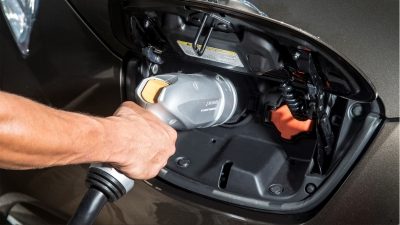REA’s Daniel Brown assesses the slew of new EV policy and regulatory proposals just released by the UK’s Office for Low Emission Vehicles

source
Daniel Brown is policy manager and electric vehicle lead at the Renewable Energy Association. To get involved in the REA’s EV work, get in touch.
Regulation Island: Will electric car charging thrive after OLEV intervention?
Pushed out just days before Boris Johnson’s great reshuffle, the UK’s Office for Low Emission Vehicles (OLEV) delivered two consultations, two calls for evidence, and a major market announcement – all of which effectively amount to transforming the largely unregulated charging infrastructure sector into a regulated one.
The UK’s EV market is a rapidly evolving sector and we welcome the government’s recent steps to give the infrastructure portion of it some additional structure. Over the past two years we’ve seen the entry of over twenty companies into the charging infrastructure market, plus the emergence of numerous start-ups, and the expansion of major utilities and oil majors into the energy supply, infrastructure, and associated services sectors.
The proposals include mandating chargepoints in new dwellings and commercial properties with parking spaces, which is above and beyond the baseline being adopted across EU member states. The ‘smartness’ of private chargepoints, such as those installed in homes and workplaces, is to be set, meaning that they will need to be able to send and receive signals that can manage load, respond to power prices, and optimise CO2 intensity. For public infrastructure, such as that along motorway services, credit and debit card options on rapid DC chargers are to be required.
“The timing of all this is key. If the decision had been taken to wait for new ministers to get up to speed, to review draft policy, and to make comments on it, the process of putting in place an effective regulatory regime could have been set back a year.”
By and large, the proposals represent progress for the sector. Our charging infrastructure needs to complement the rollout of variable renewable power generation, integrate with electrified heating and energy storage, and deliver other government objectives around security and choice. Employing building regulations to grow a sector is a crucial tactic and, if anything, we would encourage them to go further and mandate renewable heating, onsite generation, and storage in new buildings too (which should be looked at through the proposed Future Homes Standard to decarbonise heating in new homes from 2025). Public charging infrastructure also needs to be reliable, accessible, and straightforward to use.
But, as with any consultation, there is now much detail for the industry to engage with. If we agree that users of private charging infrastructure – and other smart appliances, such as storage – need to be able to switch the company that operates it, how should this be implemented? Do we agree that communications should be run through smart meters? Who should have access to chargepoint data? How do we go beyond card payments at public rapid chargers and ensure true interoperability between charge point operators for consumers? How do the proposals fit in with the work of the EV Energy Taskforce? Who should be in charge of enforcing this whole thing?
The timing of all this is key. If the decision had been taken to wait for new ministers to get up to speed, to review draft policy, and to make comments on it, the process of putting in place an effective regulatory regime could have been set back a year. And with solar and battery storage prices falling, and battery electric vehicle (BEV) sales rising, now is the time to ensure that our charge points complement other developments in the energy sector.
The next two years are going to be crucial for the industry as new players and products emerge and as we move beyond green ‘first movers’ into a more mass market. We welcome the government’s willingness to provide structure and are excited at how the sector could prosper.
This blog first appeared in BusinessGreen.

